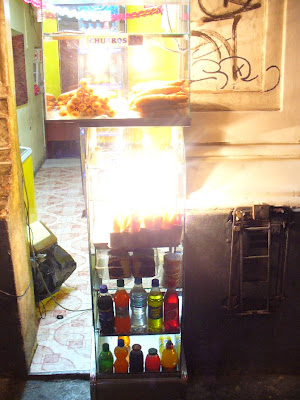
Part of the Cordano's collection of old (unopened) drink bottles. I was delighted to find among them three bottles of Old Tom gin, a now extinct variety of gin once used to make the Martinez cocktail, a precursor to the Martini.
 Basilica de Nuestra Señora de la Merced, on the 3rd block of Jirón de la Unión. The church was begun in 1535 but its ornate Baroque front was carved in 1591.
Basilica de Nuestra Señora de la Merced, on the 3rd block of Jirón de la Unión. The church was begun in 1535 but its ornate Baroque front was carved in 1591. Neocolonial-style façade of the Archbishop's Palace, built in 1924, next to the Cathedral in the Plaza de Armas, Lima's main square.
Neocolonial-style façade of the Archbishop's Palace, built in 1924, next to the Cathedral in the Plaza de Armas, Lima's main square. Interior of the chapel between the Archbishop's palace and the Cathedral.
Interior of the chapel between the Archbishop's palace and the Cathedral. Building which once housed the Couret photographic studio. Eugenio Courret, a French photographer, arrived in Lima in 1860 and in 1863 established the Fotografía Central studio on Jirón de la Unión with his brother, Aquiles. They ran the studio until 1887. In that time the Courrets documented Lima's scenery and society, leaving some 54,000 glass negatives, some of which can be viewed online.
Building which once housed the Couret photographic studio. Eugenio Courret, a French photographer, arrived in Lima in 1860 and in 1863 established the Fotografía Central studio on Jirón de la Unión with his brother, Aquiles. They ran the studio until 1887. In that time the Courrets documented Lima's scenery and society, leaving some 54,000 glass negatives, some of which can be viewed online. Old balconies on Jirón Huancavelica. The second one, with the lamp by the doorway, was once the home of Peru's most highly regarded naval hero, Admiral Miguel Grau Seminario who, at the helm of the Huáscar, held off a Chilean invasion for six months during the War of the Pacific (1879-1884). He was killed by a shell during the Battle of Angamos on 8 October, 1879.
Old balconies on Jirón Huancavelica. The second one, with the lamp by the doorway, was once the home of Peru's most highly regarded naval hero, Admiral Miguel Grau Seminario who, at the helm of the Huáscar, held off a Chilean invasion for six months during the War of the Pacific (1879-1884). He was killed by a shell during the Battle of Angamos on 8 October, 1879. On Jirón Carabaya, contiguous to the Presidential Palace, there is a shoe shop distuinguished for decades by a pair of gigantic plaster feet. I remember them from when I was a kid, and they were already quite old then. They're still there, in the window, advertising "Fine footwear made by hand."
On Jirón Carabaya, contiguous to the Presidential Palace, there is a shoe shop distuinguished for decades by a pair of gigantic plaster feet. I remember them from when I was a kid, and they were already quite old then. They're still there, in the window, advertising "Fine footwear made by hand."








No comments:
Post a Comment